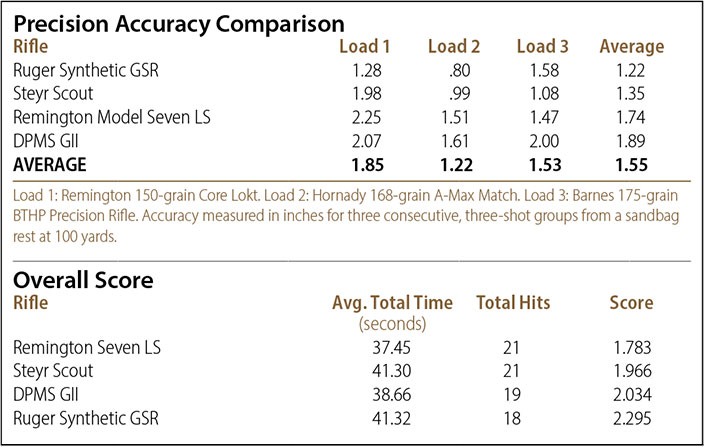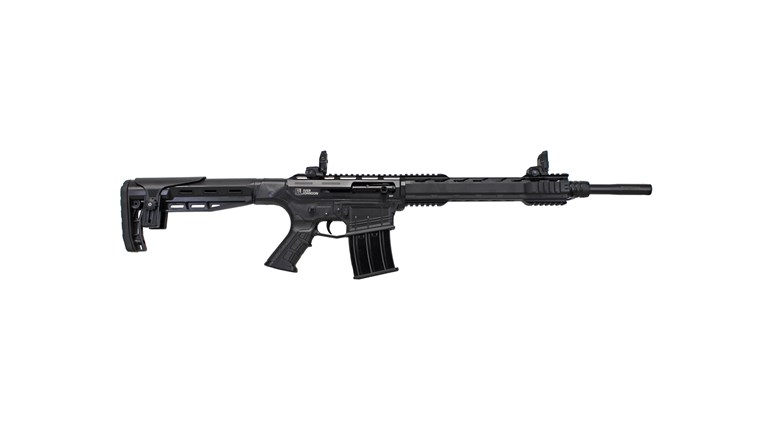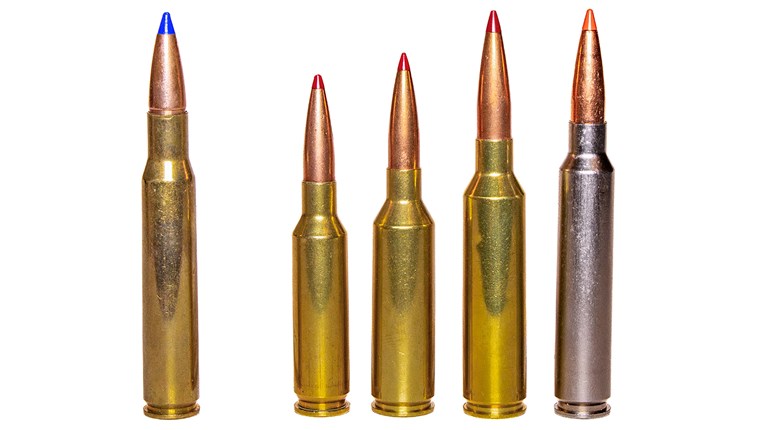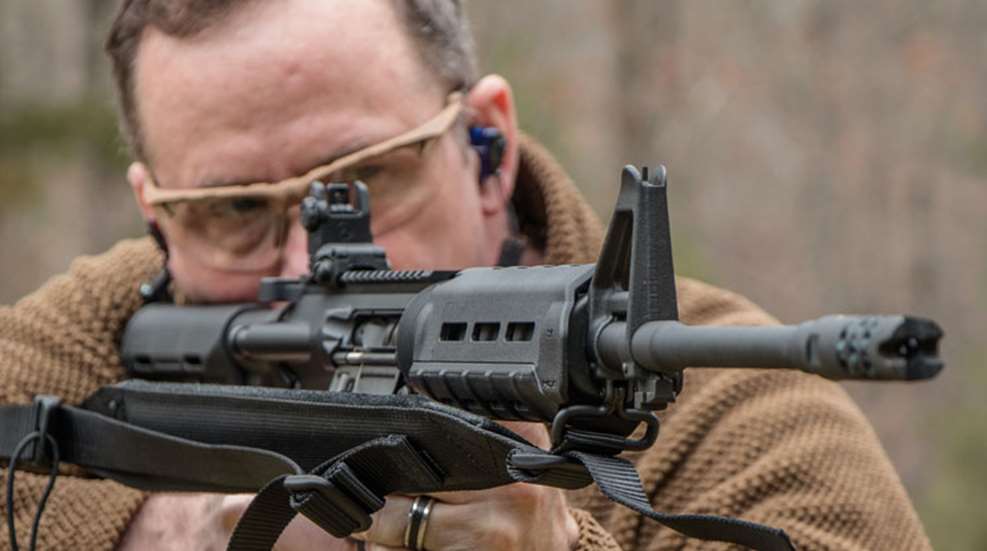
Can a modern, lightweight AR in .308 Win. serve as a scout rifle? Former Marine and Gunsite Academy founder Col. Jeff Cooper envisioned a scout rifle as short, light, handy and versatile—a full-power utility rifle; a rifle intended to do as many jobs as one weapon can. Many feel a .30-caliber AR falls within the framework of this definition.
Cooper’s scout-rifle concept was largely influenced by the turn of the 20th century Western United States and African exploits of Maj. Frederick Russell Burnham. Cooper did not consider a scout rifle a battle rifle or hunting rifle. He felt it should be suited to a man operating alone, or in a two- or three-man team, in the hunting fields, or in a military-scouting capacity. As such, performance at scout-like tasks, not weights, measures and features, should be the yardstick for determining scout-rifle suitability. A field test comparing various scout rifles to an AR seemed the best way to find the answer.
THE RIFLES
Four rifles were gathered for the exercise. Two were commercially available scout rifles and one simulated Cooper’s first scout rifle. The fourth, the subject of the question at hand, was a lightweight, .30-caliber AR. All were outfitted with Galco’s RifleMann sling and all but one was paired with an appropriate low-magnification optical sight.
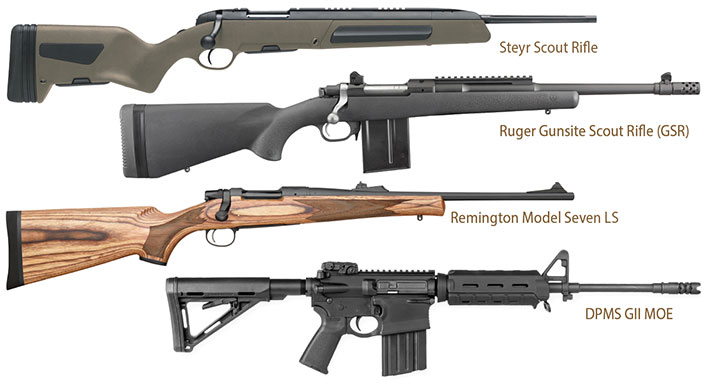
Rifle One: The Steyr Scout might be the ultimate expression of Cooper’s concept. It’s the only commercially available scout rifle built with input from the late colonel. It was fitted with a Burris 2-7X Scout Scope in Leupold QRW rings. Weight: 6.77 pounds. Length: 38.5 to 39.4 inches.
Rifle Two: Currently the most popular scout rifle is Ruger’s Gunsite Scout Rifle (GSR). The synthetic-stocked version—the lightest offered—was tested with a Leupold VX2 1.5-4X Scout Scope mounted in QRW rings. Weight: 6.22 pounds. Length: 37 to 39.5 inches.
Rifle Three: A new Remington Model Seven LS, outfitted with an XS Sight Systems ghost-ring rear and post front sight is very similar to the rifle Cooper called Scout I, which was built on a Remington model 600. Due to the poor factory trigger, a Timney Calvin Elite trigger was installed. Weight: 6.4 pounds. Length: 37.88 inches.
Rifle Four: To answer the question of whether an AR can be a scout rifle, a DPMS GII MOE equipped with a Nightforce 1-4X Compact riflescope in Leupold QRW rings was included. As with the Remington, the disappointing factory trigger was replaced with a Timney Targa two-stage. Weight: 7.34 pounds. Length: 34.5 to 38.25 inches.
The rifle weights shown are the naked weights sans an optic, magazine or sling. Cooper suggested a scout rifle should not exceed 39 inches or weigh more than 7.72 pounds unloaded, with accessories attached. The Galco sling added 6 ounces; the weights of the optics and magazines varied.
THE TEST
Forty-eight shots were fired with each rifle through a series of five drills. Every drill was conducted three times with each rifle and timed to establish an average. Drills one through four were organized to highlight the various elements of general-purpose rifle fire Cooper preached. Things like shooting from all four field positions, use of a shooting sling, snap-shooting, engaging targets with backup iron sights and working through worst-case situations were woven into the evaluation.
Drill One was conducted to establish each rifle’s snap-shooting conduciveness and to see how fast consecutive shots could be put on target at close range. It would also tell how smoothly the rifle’s action could be operated. From the standing off-hand position, three rounds were fired at a 6-inch target, at 25 yards.
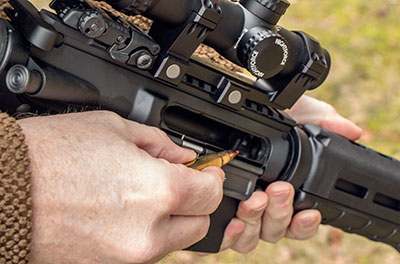
Cooper considered open sights mandatory on a scout rifle. For Drill Two, one shot was fired without optics at a 6-inch target at 50 yards. A missing magazine was induced to simulate a worst-case scenario. This could reasonably occur on a long-term scouting mission. The drill was started standing, with a rifle in one hand and one cartridge in the other. A single shot was fired from the kneeling position.
In Drill Three, one shot was fired at a 6-inch circle at 75 yards, after moving from standing to sitting. To discern each rifle’s conduciveness to being reloaded, another cartridge was inserted—either individually or from a new magazine—and a second shot was fired.
A scout rifle must also be suitable for distance engagements. Drill Four was conducted at 100 yards and a single shot was fired after moving from standing to prone. A scout rifle should be capable at greater distances but the rifle—not the wind and range guessing abilities of the shooter—were the focus of the test.
Even though Cooper stipulated a 2-MOA-minimum level of precision, for Drill Five each rifle was bench tested because modern shooters demand even greater accuracy. Three, three-shot groups, with three different loads, were fired at 100 yards, from a sandbag rest, with each rifle. The maximum time allowed for all 27 shots was 30 minutes.
THE RESULTS
With regard to precision (Drill Five), the Ruger GSR delivered the smallest group average. With only about a .5 inch separating the four rifles you could argue this was a wash. Obviously, with different loads results would vary.
As for Drill One, the DPMS GII was approximately 3 seconds—or 43 percent—faster than the bolt-action scouts. And, being a semi-automatic, there was no action-manipulation factor to evaluate. As far as the bolt-actions, the Steyr’s was by far the smoothest.
Drill Two was difficult for three of the rifles since protocol prohibited a magazine. The Model Seven, with its internal magazine, was the easiest and fastest to load a single cartridge in. The Steyr came in second due to its push-feed action. The Ruger GSR, somewhat replicating the Mauser’s controlled-round feed (CRF) system, was slower because the rim of the case had to be placed behind the extractor. This is a failing of the CRF design. The AR was a bugger to load without a magazine.
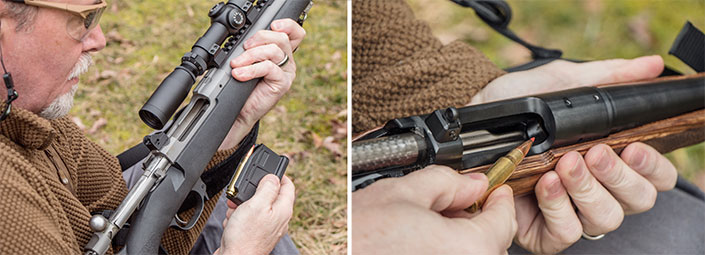
During Drill Three it was discovered that loading a single cartridge from a belt or pouch was just about as fast as inserting a new magazine. Engagement times for all rifles spanned between 14 and 17 seconds. There was no clear winner; skill with the reload was the primary determining factor.
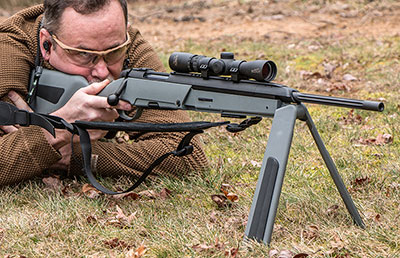
In Drill Four the times were reasonably close. However, the standout was the Steyr. Its integral and rapidly deployable bipod allowed for the most precise shots and fastest times. As flimsy as the Steyr’s bipod has been accused of being, it did make a rather substantial difference.
OVERALL EVALUATION
Scoring drills like these with numbers can be a touchy thing, but an attempt was made. Evaluating Drill Five—precision from the bench—was, on the other hand, easy; the average for all nine groups fired was used. For the four field drills, the average total time it took to perform drills one through four, in sequence, was divided by the total number of hits. The lower the score, the better. It should be noted that Remington’s Model Seven and the Steyr Scout were the only rifles to clean the course-of-fire.
Do these scores mean anything? Yes and no. Overall, a conventional bolt-action carbine with XS Sights and the Steyr Scout rifle performed the best. But, I’m of the opinion this was primarily due to the stock configuration on these rifles. It consistently allowed the shooter to place their eye behind the sights with a solid and repeatable cheek weld. With the Ruger GSR and the DPMS GII, proper cheek welds placed the eye below the line of sight, very likely contributing to the slower times and misses. A different stock on the GII or a built-up comb on the GSR could correct this deficiency.

Perhaps more importantly, we should look at the maximum variance in the average total time required to complete the four field exercises. This amounted to 3.87 seconds and works out to only 0.184 seconds per shot. Practically speaking, this difference is of absolutely no consequence and from a real-world standpoint you could consider it a four-way tie.
Cooper’s concept of the scout rifle was to provide armament for a man securing sustenance or reconnoitering real estate. It was never intended to be a fire-team weapon; Cooper was clear that volume fire was never an important characteristic of a scout rifle. Handiness, part of which lightweight and compactness are primary elements, is what Col. Cooper considered most important.
You’ll struggle mightily to meet Cooper’s 6.6- to 7.7-pound weight limit with any optically sighted .308 Win. rifle. The Ruger GSR comes closest, while the DPMS GII MOE is the furthest from that mark. And, field-readying these rifles with slings and optics only makes them heavier. Interestingly, given the good lighting conditions the test was conducted under, the XS Sights on the Remington Model Seven were just as effective as optics.
Based on this experiment it would appear that from a pure field performance standpoint, the DPMS GII MOE is just as much a scout rifle as anything else. Of course, true Cooper disciples or scout-rifle aficionados will argue about a lot of weights and measures, along with Cooper’s bias against semi-automatic rifles. An AR may never meet Cooper’s scout rifle definition and we’ll never know if he would’ve accepted one as a scout rifle. Ultimately, what really matters is what can be done with the rifle, not what it is called.
